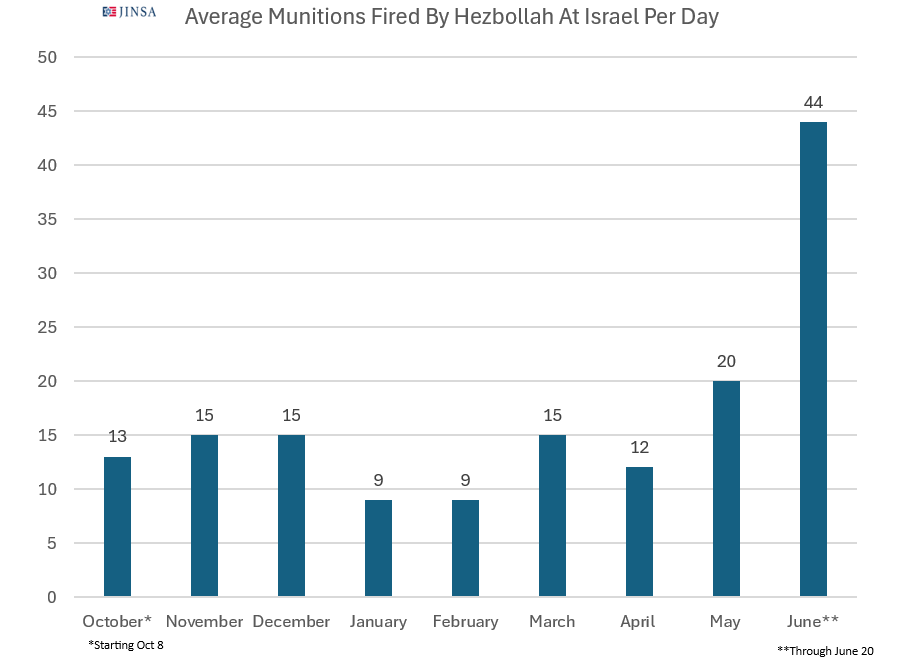Australia/Israel Review
Hezbollah’s massive firepower threat
Jul 3, 2024 | Yaakov Lappin

As the ongoing waves of Lebanese projectile and drone attacks on northern Israel demonstrate, targeted strikes, such as the elimination of high-ranking operatives like Sami Taleb Abdullah, aka Abu Taleb, on June 11, may serve as tactical achievements for Israel. However, they fall short of strategically degrading the severe threat posed by the Hezbollah terror army and its massive arsenal.
While targeted strikes can disrupt command and control temporarily, they do not degrade the underlying military capabilities of the Iranian-backed Hezbollah.
Hezbollah’s response to Abu Taleb’s assassination – firing over 300 rockets, and UAVs, at northern Israel within 48 hours, including targeting the Plasan Sasa defence company that manufactures armoured vehicle parts – underscores its capacity to mobilise and implement large-scale, precise attacks rapidly, and how this ability is not dependent on any single commander.
Meanwhile, Hezbollah has been making increasingly effective use of Almas guided anti-tank missiles, which are based on Israeli-made Spike missiles that were captured in the 2006 Second Lebanon War and reverse-engineered by the Iranians, to target military bases in the north. Hezbollah has also used precise weapons to try to knock out Iron Dome air defence batteries. It is using the current conflict to adapt and learn at a troubling pace.
Hezbollah’s widespread attack on the north on June 12 demonstrated that the core threat lies not in any individual commanders but in the substantial firepower array that is entrenched deeply throughout 200 southern Lebanese Shi’ite villages, as well as in Beirut and the Beka’a Valley.

Hezbollah’s daily attacks on Israel have escalated sharply in recent weeks (Graphic: JINSA)
The June 11 Israeli Air Force targeted strike in the southern Lebanese village of Jwaya killed the most senior Hezbollah commander since the war began, and delivered a stinging blow to the Shi’ite Lebanese terror army, due to the intelligence infiltration of its activities. Yet this, unfortunately, will not be a game changer in terms of the threat posed to Israel.
Abdullah, who was commander of Hezbollah’s territorial Nasr Unit – the equivalent of a division commander – was killed along with three other Hezbollah operatives in the strike on a Hezbollah headquarters.
As the Alma Research and Education Centre recently noted, the Nasr Unit, like the Badr and Aziz units of Hezbollah, has a designated geographic territory in southern Lebanon from which it fires rockets, anti-tank missiles, UAVs and other weapons at northern Israel, and would be in charge of confronting any future Israel Defence Forces ground offensive.
The death of Abu Taleb, although a significant moral blow, did not cripple Hezbollah’s ability to retaliate swiftly and forcefully. The immediate response from Hezbollah was a barrage of over 250 rockets into northern Israel, causing widespread fires and damage.
Hezbollah’s military-terrorist infrastructure and expansive manpower pose the largest conventional threat to Israel. The limitations of targeted strikes as an approach are becoming increasingly evident, as with the IAF’s ongoing campaign to strike at Hezbollah weapons storage centres and command posts in a limited fashion, in line with the Israeli War Cabinet’s directives.
Israel continues to prioritise the Gaza arena and the War Cabinet instructed the IDF to keep the northern flames from reaching high intensity. The north, meanwhile, continues to burn.
Hezbollah’s military-terrorist apparatus is unprecedented. Its firepower arsenal can only be matched by a handful of military powers. Its extensive, well-organised and deeply embedded army nestles within Lebanese Shi’ite civilian society. Hezbollah’s arsenal of more than 200,000 warheads includes tens of thousands of rockets and missiles, 140,000 mortar shells, precision-guided munitions and unmanned aerial vehicles. This arsenal allows Hezbollah to sustain prolonged conflicts and execute precision strikes against Israeli targets.
Hezbollah’s increasingly effective use of UAVs in recent weeks is another reminder of this persistent threat. Hezbollah is using the current conflict to rapidly learn how to launch UAVs at sensitive military facilities in Israel.
In recent weeks, Hezbollah has deployed drones with greater frequency and effectiveness, targeting military sites in northern Israel and terrorising northern communities. On June 10 and 11, Hezbollah’s UAV attacks caused significant damage and fires in several locations in northern Israel.
100,000 men
With 50,000 active members and an equal number of reservists, Hezbollah maintains substantial manpower, allowing the group to absorb losses from targeted strikes and continue its operations with minimal disruption.
Hezbollah’s organisational structure, Iranian funding flows (estimated at around US$700 million, or A$1.05 billion, per year) and recruitment capabilities ensure a continuous flow of personnel to replace losses. Hence, even significant casualties among high-ranking members can be mitigated, allowing the group to sustain its operations over the long term.
As Israel has learned from eight months of war in Gaza, only a ground incursion could significantly uproot such an entrenched threat, but it is up to the Cabinet to decide, soon, whether to activate this option or to try to delay the next northern war, which could also draw in Iran directly.






